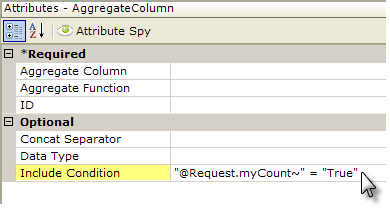The Aggregate Column
An Aggregate Column element adds a new column to the datalayer that represents an aggregated value of the data in one of the other columns in the datalayer.
The following topics discuss the Aggregate Column element:
About the Aggregate Column
The Aggregate Column is similar to other elements designed to extend the data available in a datalayer. Like the Calculated Column element, the Aggregate Column is added as a child element beneath a datalayer and adds a new column to the datalayer. This column contains derived data which is accessible using an @Data token.
The new column's value is the result of aggregating the value of the data in one column, for all rows, in the datalayer. The aggregated value is populated in the new column in every row of the datalayer so that it can be used in further calculations, Summary Rows, Link Params, etc. It is also populated in the top-level row, allowing reference to the value anywhere in the report outside of a Data Table.
Similar aggregations can be performed within SQL queries and may offer faster performance when done by the database server. However, the Aggregate Column element allows aggregations to be performed on data from other sources too, such as web services and data files, that do not themselves offer aggregating functions.
Dynamic Application
The Aggregate Column element has an Include Condition attribute:

If the value of this attribute is left blank or contains a formula that evaluates to True, the element is applied to the datalayer. If the value evaluates to False, the element is ignored and does not affect the datalayer. This powerful feature allows developers to dynamically determine if the Aggregate Column will be added to the datalayer or not.